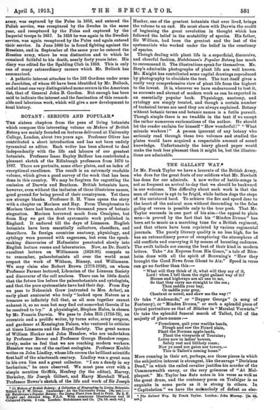BOTANY: SERIOUS AND POPULAR.*
THE sixteen chapters from the pens of living botanists which compose this interesting volume on Makers of British Botany are mainly founded on lectures delivered at University College, London, about two years ago. Professor Oliver has contributed a abort introduction and has not been unduly tyrannical as editor. Each writer has been allowed to deal independently with the life and labours of our greatest botanists. Professor Isaac Bayley Balfour has contributed a pleasant sketch of the Edinburgh professors from 1670 to 1887. There are portraits, some other plates, and an index of -exceptional excellence. The result is an extremely readable volume, which gives a good survey of the work that has been done in this country. We may be forgiven for regretting the omission of Darwin and Bentham. British botanists have, however, even without the inclusion of these illustrious names, good ground for being proud of their countrymen. Yet there are strange blanks. Professor S. H. Vines opens the story with a chapter on Morison and Ray. From Theophrastus to 'Morison there bad been about two thousand years of botanic stagnation. Morison borrowed much from Cesalpino, but from Ray we get the first systematic work published in England. It endured till the days of Linnaeus. English botanists have been essentially collectors, classifiers, and describers. In foreign countries anatomy, physiology, and cytology were pursued with eagerness, but even the epoch- making discoveries of Hofmeister penetrated slowly into English lecture rooms and laboratories. Now, as Dr. Scott's excellent lecture on Williamson (1816-95) compels us to remember, palaeobotanista all over the world must respect the work of Witham, Binney, and Williamson.
• We may claim also Robert Brown (1773-1858), on whom 'Professor Farmer lectured, Librarian of the Linnean Society and discoverer of the cell nucleus. There can be little doubt that the future lies before the palaeobotanists and cytologist; and that, the pure systematists have bad their day. From Ray we pass to Nehemiah Grew (entrusted to Mrs. Arber), an early plant anatomist who truly "looked upon Nature as a treasure so infinitely full that, as all men together cannot exhaust it, so no man but may find out somewhat therein if he be resolved to try." A physiologist, Stephen Hales, is chosen by Mr. Francis Darwin. We pass to John Hill (1716-75), an eccentric and a prolific writer, by turns actor, army surgeon, and gardener at Kensington Palace, who ventured to criticise at times Linnaeus and the Royal Society. The great names of William Hooker and John Henslow, who are undertaken by Professor Bower and Professor George Henslow respec- tively, make us feel that we are reaching modern workers. Henslow was one of the earliest ecologists. Professor Keeble writes on John Lindley, whose life covers the brilliant scientific first half of the nineteenth century. Lindley was a great man in his own line and a great collector. "I am a dandy in my 'herbarium," he once observed. We must pass over with a simple mention Griffith, Henfrey (by the editor), Harvey, Berkeley, Sir Joseph Gilbert, and Harry Marshall Ward. Professor Bower's sketch of the life and work of Sir Joseph
• (1) Makers of British Botany : A Collection of Biographies by Living Botanists. 'Edited by F. W. Oliver. Cambridge : At the University Press. [8s. net.]— (2) Hutchinson's Popular Botany the Living Plant from Seed to Fruit. By A. E. Knight and Edward Step, P.L.S. With numerous Illustrations 8.nd 18 • Coloured Plates. 2 vols. London: Hutchinson and Co. [7s. ed. each vol.]
Hooker, one of the greatest botanists that ever lived, brings the volume to an end. He must share with Darwin the credit of beginning the great revolution in thought which has followed the belief in the mutability of species. His father, Sir William, had been the greatest and the last of the systematists who worked under the belief in the constancy of species.
Though dealing with plant life in a superficial, discursive, and cheerful fashion, Hutchinson's Popular Botany has much to recommend it. The illustrations speak for themselves. Mr. Step's admirable photographs of plant life are well known. Mr. Knight has contributed some capital drawings reproduced by photography to elucidate the text. The text itself gives a really very comprehensive view of plant life from the highest to the lowest, it is, wherever we have endeavoured to test it, as accurate and abreast of modern work as can be expected in an essentially popular book. Physiology, anatomy, and cytology are simply treated, and though a certain number of technical terms are used they are always explained. Botany without botanic terms and botanic names is a futile pursuit. Though simple there is no twaddle in the text if we except the rather numerous exclamations of the author. He should let the reader exclaim for himself "How wonderful!" "What miracle workers !" A person ignorant of any botany who seriously read through these two volumes and studied the plates would have acquired a respectable amount of sound knowledge. Unfortunately the heavy glazed paper would make the task less pleasant than it might be, but the illustra- tions are admirable.














































 Previous page
Previous page